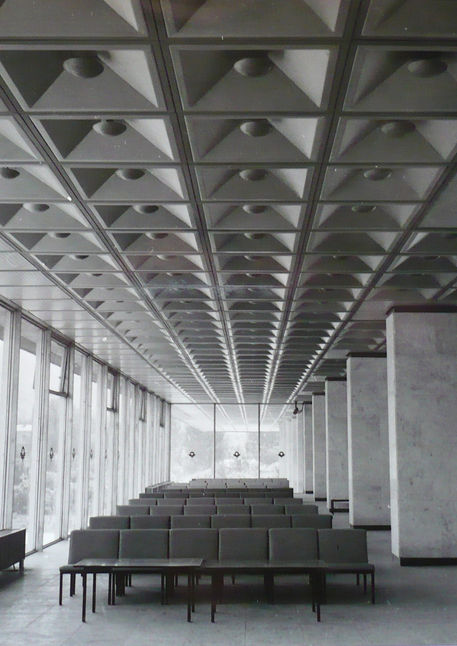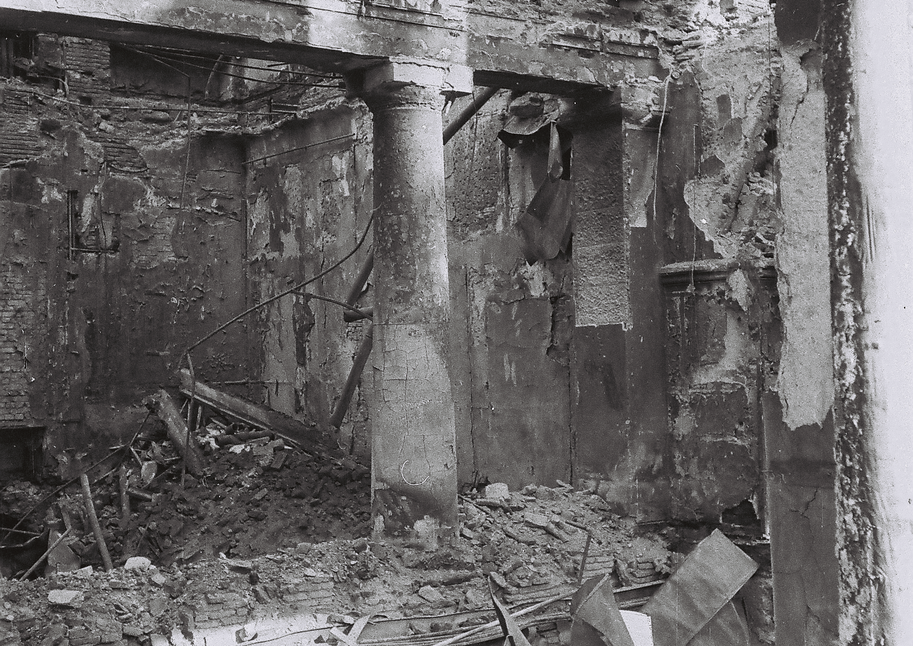Collection: Photography
Baratashvili Bridge. 1960s

This is a high-quality series of photographs from the architect's estate, which was gradually recorded after the completion of the Baratashvili Bridge in Tbilisi. They are dignified representations of progress, radical change and the spirit of the times. This original, functionally-based construction was a far cry from conventional bridge architecture of the time. Underneath the bridge exhibition space (right side) and café pavilion (left side) were opened, which made the complex particularly attractive. The exhibition hall only existed for 20 years; it was closed during the perestroika period in the mid-1980's. The photos were probably taken with the 35 mm camera Zenit ET (made in USSR) and printed on SVEMA (the most important manufacturer of photographic film in the Soviet Union) glossy or matt cardboard white photo paper.
Central Bus Station. 1974

These square-format photographs from the architect's estate show the empty interior of the Tbilisi Central Bus Station in the Ortachala district. Tall glass façades and staircases as well as predominantly light colours give the building a spacious elegant feel. In the interiors are used local materials – granite and white marble. These photographs owe their quality, among other, to the functional planning and his masterly, almost cinematic light arrangements. The series is photographed after the completion of the building in 1974. The photos were presumably taken with the 35 mm camera Zenit ET (made in USSR) and printed on SVEMA (the most important manufacturer of photographic film in the Soviet Union) glossy white photo paper.
Hotel Orient / House of Artists. 1992

This series was photographed just after the end of the civil war in Tbilisi. Documented is Hotel Orient /House of Artists – the iconic building that once existed in Georgia's capital. Designed in classical style by Otto Jacob Simonson and later rebuilt as a hotel by Albert Salzmann, it stood in the beginning of Rustaveli Avenue. First it housed the municipal court house (1867), then the luxury Hotel Orient (1895) later the Intourist Hotel (1949-1979) and in the 1980s the House of Artists – the centre of Georgian subculture. During the civil war in the winter of 1991-1992, this building served as a staff office for a paramilitary group. In 1994, this badly damaged building was demolished in doubtful circumstances. The photos were taken with the analog camera (Zenit ET, made in USSR) and printed on SVEMA glossy photo paper.
Rustaveli Avenue 18th / 19th / 20th cent.

The photographs reflected the development of Rustaveli Avenue. It took on a new character since the 1860s: monumental public buildings were erected there, giving the avenue a metropolitan character: The Palace of the Governor (1869), the facades of the Classical Gymnasium were rebuilt (1871), the Museum of Glory (1885). At the end of the 19th century, the St. Alexander Nevsky Military Cathedral stood at the beginning of Avenue. It was located in Ghunibi Square, on the spot where lower government building stands today. In the 1930s, this cathedral was razed and on the same spot construction of the government building began; back building were completed in 1938. In 1953 the main building facing the avenue was completed, which, brought new hypertrophic shapes to the city centre. The photos were printed on SVEMA glossy photo paper.
Stockholm, Sweden 1970s

In the 1960s and 1970s, when travelling to the Central European countries was not yet easy, became popular for the Soviet elite visits to the Scandinavian countries. Sweden was considered as the least dangerous capitalist country, hence more tourist and business trips (not last for the purpose of “critical learning from abroad” N. Khrushchev) had been permitted by the Soviet authorities. In 1965 the so-called Million Programme housing project was implemented in Sweden. Its aim was to build one million high standard rental accommodations during the Programme's ten-year period. The photo series is a fascinating reflection on the European lifestyle. It shows a brighter, kinder world, full of green fields and white houses, epitomizing the optimistic modern life.
Dubrovnik, Yugoslavia 1960s

This series of black and white photographs was taken in Dubrovnik, former Yugoslavia, during a tourist trip. They include the magnificent Placa Stradun, the main street of Dubrovnik, lined with baroque and medieval buildings. The photos are annotated on the back by W. Kurtishvili: "Main street of the Dubrovnik. The 13th century town has many holiday visitors in winter as well as in summer; The whole town runs with terraces to the sea; Dubrovnik is surrounded by a large medieval wall that protected the Republic of Dubrovnik from enemy invasions. Now the wall is a popular place for tourists." The photos were taken with the analogue camera (Zenit ET, made in the USSR) and printed on SVEMA matt photo paper. Original prints are still in very good condition.

































